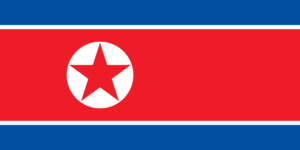by The Cowl Editor on September 21, 2017
National and Global News
By Thomas Edwards ’20
News Staff

Since the conclusion of the Korean War in 1953, the Korean Peninsula has been divided along the 38th parallel, forming two countries: North Korea and South Korea. North Korea, which follows a communist ideology, has had three successive rulers of the same family: Kim Il-sung, Kim Jong-il, and currently Kim Jong-un. Their leadership and ideologies have been a consistent area of conflict since the establishment of the regime. With heavy sanctions on their country placed by the United Nations and a call to keep them from achieving nuclear capabilities, North Korea has often remained on the side lines. In recent months, however, Kim Jong-un has brought North Korea into the lime light once more.
January 1, 2017
Kim made the announcement that North Korea could soon test an intercontinental ballistic missile. In response, former U.S. Secretary of Defense, Ash Carter, stated plainly that any ballistic missile launched at the United States would be shot down.
July 4, 2017
There is another missile test, which North Korea claimed could reach anywhere in the world. Shortly following this test, North Korea threatened to launch a nuclear strike on the heart of the U.S. if there are ever attempts to remove Kim Jong-un from power.
August 7, 2017
North Korea accused the United States of attempting to force the Korean Peninsula into a nuclear war. This was stated after the United Nations Security Council unanimously voted for new sanctions in response to the ballistic missile tests in July.
August 9, 2017
The threat of a North Korean attack became visible in the eyes of the world. Despite North Korea’s claims in their abilities to strike anywhere in the world with a missile, countries were not concerned since the furthest their missiles had gone before was 2,300 miles, which is just past Japan. On Aug. 9, however, the North Korean military announced they were “examining the operational plan” to strike areas around the territory of Guam with medium-to-long-range strategic ballistic missiles. Guam is only 2,100 miles away from North Korea and therefore within their missile launch zone. This announcement followed one day after President Donald Trump warned North Korea that any more threats towards the United States would cause “fire and fury like the world has never seen.” Since then, Kim Jong-un’s regime and the Trump administration have been sending threat after threat to one another.
September 3, 2017
North Korea carried out its sixth test of a nuclear weapon which caused a 6.3 magnitude seismic event, as measured by the United States Geological Survey. North Korea claimed the explosion to have been from a hydrogen bomb that could be placed on an intercontinental missile. A nuclear weapons monitoring group described the weapon as up to eight times stronger than the bomb dropped in Hiroshima in 1945. President Trump responded to the test by tweeting that North Korea continued to be “very hostile and dangerous to the United States,” and went on to criticize the South Korean government by claiming the country is engaging in “talk of appeasement” with North Korea. President Trump then went on to call North Korea “an embarrassment to China,” and claims Beijing is having little success reigning in Kim Jong-un’s regime.
September 15, 2017
President Donald Trump spoke at Joint Base Andrews, the Air Force installation outside Washington, where he emphasized the strength of the U.S. military options, saying, “After seeing your capabilities and commitment here today, I am more confident than ever that our options in addressing this threat are both effective and overwhelming.” His statement was directed at North Korea and Kim Jong-un’s regime. On Saturday, September 16, National Security Advisor H.R. McMaster made it clear that time was running out to deal with North Korea, saying, “For those who have said, and been commenting about a lack of an military option, there is a military option,” later adding, “Now, it is not what we would prefer to do.” However, he, made it clear that the United States is considering military actions against North Korea should they be necessary.
As of now, that is where the situation in North Korea stands. With tensions escalating across the globe, it is rather unclear where this may lead. But, the Trump administration is weighing all of their options and working with other countries within the United Nations countries to resolve the situation.